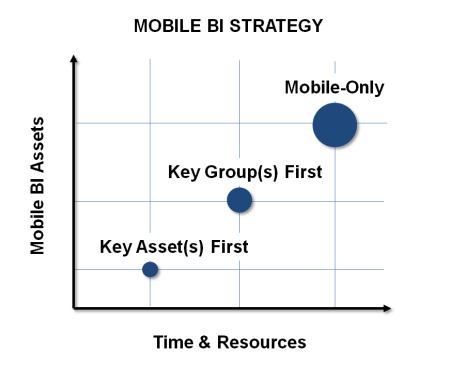In my post “Mobile BI” Doesn’t Mean “Mobile-Enabled Reports” I highlighted two main areas that affect how organizations can go about realizing the benefits of mobile business intelligence (BI): enterprise mobility and BI maturity. Today I want to focus on the latter and outline high-level strategies that require different avenues of focus, time, and resources.
Before an organization can execute these high-level strategies, it must have the following:
- An existing BI framework that can be leveraged
- Current technology (hardware and software) used for BI that support mobile capabilities
- A support infrastructure to address technical challenges.
If an organization meets these minimum prerequisites, then there’s a greater chance for success. Thus, the higher the level of BI maturity, the better a head start an organization gets on its mobile BI journey.
“Mobile-only” strategy
A “mobile-only” strategy reflects a strong commitment, or all-in approach, by the management team to mobile BI, or mobility in general. This may be due to a specific reason, such as the relevance of mobility in a particular industry or the opportunity to create a strategic advantage in a highly competitive market. Or a company may decide that mobility needs to be a vital part of their vision.
However, in order for this strategy to be successful, it requires a commitment that results in both championing the cause at the board or senior management level and making the necessary resources available for execution at the tactical level.
In reality, this approach doesn’t necessarily translate into creating a mobile version of every analysis or shutting down all production lines for PC-based outlets for reporting and analytics. Instead, it reflects a strong emphasis on establishing scalable mobile consumption paths for analytics, and it signals a willingness to exploit a mobile-first mindset.

“Key asset(s) first” mobile strategy
Organizations that aren’t ready or don’t have the resources for a mobile-only strategy may be forced to pursue a less ambitious approach. This would enable such organizations to supplement their existing BI portfolio with key analyses delivered in mobile BI, resulting in a smaller initial investment and reduced pressure to overhaul large stacks of assets, so to speak.
With the “key-assets-first“ strategy, the spotlight is on finding key BI areas of focus that can both return the maximum value when delivered effectively on mobile platforms, and can directly support the execution of the business strategy in the short-term. For example, the business strategy may include expansion into a new market, and the mobile BI may deliver analytics to help sales teams to sell more and provide management with insight into forecast and pipeline.
To me, this is the most flexible strategy because it doesn’t commit to an all or nothing approach. Most importantly, it differentiates between what may be conducive to mobile-ready consumption and what can produce the maximum impact by ignoring those assets with marginal returns on investment.
“Key group(s) first” mobile strategy
A “key-group-first” strategy makes a considerable commitment to arm a particular group or groups in an organization with a complete set of capabilities that can be delivered in mobile BI. This hybrid strategy identifies the best candidate group(s) for mobile BI and delivers an end-to-end solution. At minimum, it may consider the existing BI framework, the BI culture (history in terms of successes and failures), the BI adoption across the enterprise, and the current BI asset portfolio to develop this more comprehensive approach.
For example, sales teams, which travel and spend a lot of time in the field, tend to benefit most from mobility. If they’re selected as the target group, the mobile BI strategy’s goal will be to provide them with a comprehensive package of sales-centric BI assets. Thus existing capabilities in enterprise mobility for sales teams may compliment not only the delivery of new mobile BI resources but also the greater adoption of mobile BI content.
Mobile BI bottom line
The fundamentals don’t change–a smart mobile BI strategy needs to contribute to growth or to profitability. In order to deliver the true business value for mobile BI, all three strategies must embrace the common objectives of an integrated mobile intelligence framework. They must leverage the technology’s strengths as well as minimize its weaknesses within a supported infrastructure.
The mobile intelligence framework can’t exist separately from, or independent of, the organization’s business or technology strategy.
What is your start-up strategy for mobile BI?
Stay tuned for my next blog in the series, Ten Questions To Develop Your Mobile BI Strategy.
Kaan
Connect with me on Twitter (@KaanTurnali) and LinkedIn
